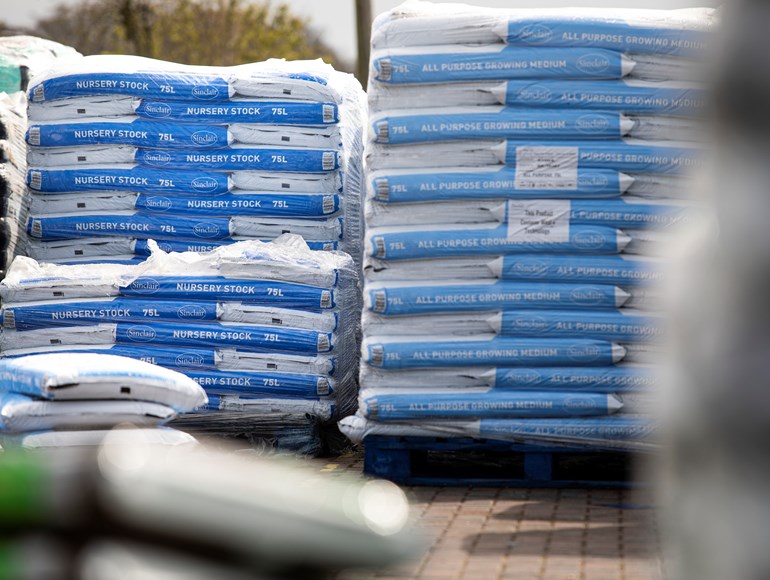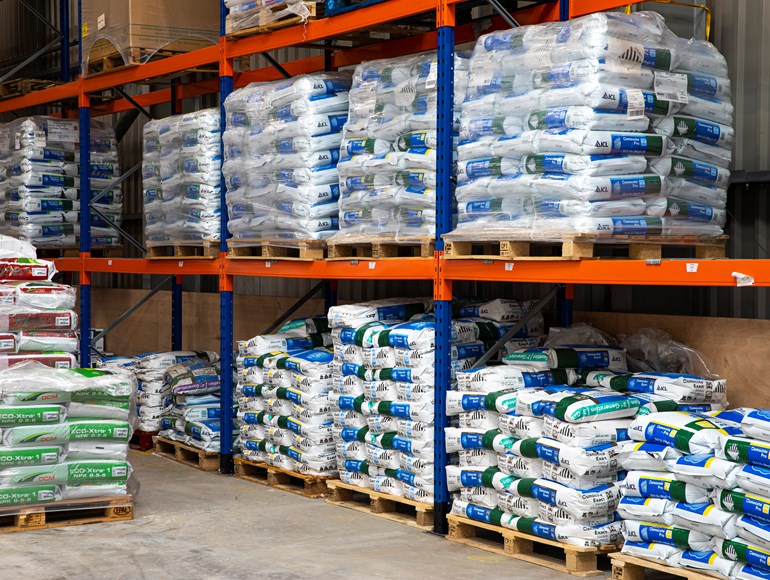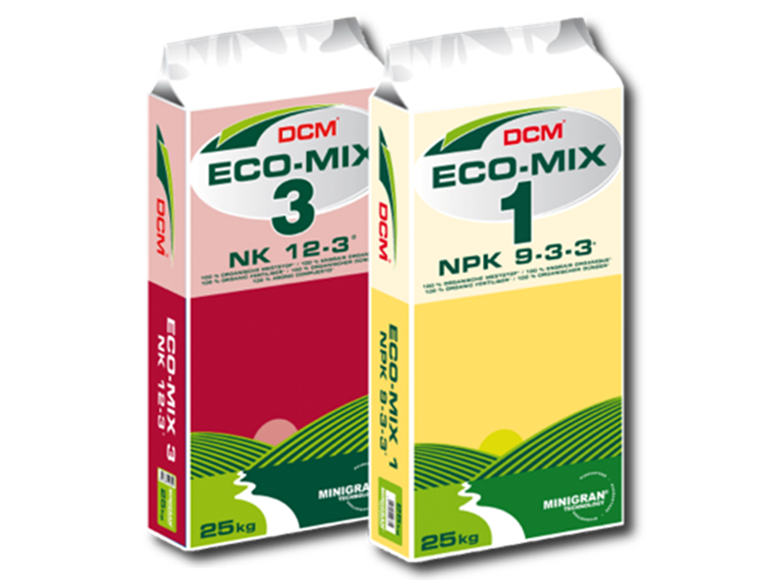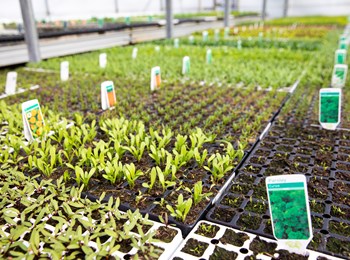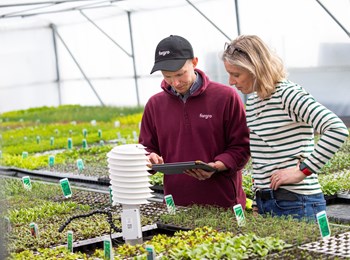
Fargro's Growing Media and Fertiliser Specialist
Sean Whitworth is Fargro's Growing Media and Fertiliser Specialist, with him being an expert in the field, we put a few questions to him to help share some of his valuable knowledge with you.
What key things should growers be thinking about at this time of year, with regards to growing media?
As most crops planted now are for overwintering, it is important to use the right substrate mix for the crops grown. The substrate would need to have a good air-filled porosity, which is particularly important at this time of year to keep the correct moisture content for the crop growing.
What is air-filled porosity?
Air-filled porosity is a very important physical characteristic to understand. This can be thought of as the space between soil particles at a given time that is not filled with water. Knowing the air-filled porosity of a mix can allow for better-informed decisions on irrigation and nutrient management. Further to this, better soil aeration has been shown to promote advantageous root growth, drive rates of photosynthesis, and ultimately produce a healthier more robust plant that copes better under stressful conditions.
Why is moisture content important at this time of year?
Water management is critical all year round, but it is worthwhile to remember the fundamentals. At this time of year increased rainfall coupled with low VPD increases the possibility for plants to be sitting wet. A low VPD ultimately will mean a low force of evapotranspiration and a reduced transpiration pull, so less water being pulled out of the growing media into the plant. Sitting wet has profoundly negative effects on root and plant development, nutrient uptake, and photosynthesis.
Wet conditions create a more anaerobic environment, this favours the development of “damping off” diseases such as Phytophthora and Pythium. Further down the line, this will increase the likelihood of the development of secondary pests and diseases such as botrytis and fungus gnats (Eg; Scatella and Scarid fly).
What key things should growers be thinking about at this time of year, with regards to fertiliser?
As we go into winter, lower light levels and colder temperatures will mean less watering of the crops, so there will be less opportunity to add the fertilisers needed by the crop to grow.
In glasshouse crops, to avoid underfeeding you can feed with a higher EC, and because you are watering less often, this will keep the right EC level in the crop. Don't forget it is important to take soil samples to keep checking feed levels in the crop, adjusting the EC and NPK as necessary.
Another option for some glasshouse crops is to top dress with a DCM organic fertiliser, in the trials we have been conducting with growers we've seen this has helped in the nutrition of the crops grown without the need for liquid feed.
How does this change for Hardy Nursery Stock?
On hardy stock and perennial crops where predominantly Osmocote is used, we've looked at what happens over the winter where the temperature can go too low for Osmocote to work effectively. We've conducted trials top dressing with the DCM organic fertilisers, and have seen great results at lower temperature on crops which have needed the extra nutrition.
What are your predictions for the future of fertilisers in the next 10 years?
Over the next few years, as an industry, we will be looking more at the environmental issues and what affect fertiliser run-off can have on the environment, so with this in mind it is important growers look at their fertiliser usage and watering systems to reduce the amount of run-off and leaching from the crops grown.
How are these changes being driven?
Increasing societal and political pressures are likely to see a shift in fertiliser usage from inorganic to organic fertilisers. Organic fertilisers tend to be derived from plant or animal sources. Organic products like fish blood and bone and poultry manure pellets tend to be slower acting and not uniform in their release patterns, so often lead to inconsistent results.
The next generation of organic fertilisers such as DCM offers a reliable controlled organic release ensuring that the correct levels of nutrients are released over a specified time to meet a plant's growth demands. This means growers can have greater confidence that these alternative products will give efficacious results.
What work is Fargro doing to ensure growers have sustainable fertiliser programmes going forward?
At Fargro we are studying DCM organic fertilisers and the effects they have on crops and nutrition, enabling us to use them alongside liquid and slow-release fertilisers. So far we have seen good results where an organic fertiliser is used in a liquid fertiliser programme, reducing the EC used in the mineral fertiliser.
Growers can look to integrate organic fertilisers alongside inorganic fertiliser programmes to reduce synthetic inputs rather than doing a straight switch. This can allow growers to increase their confidence in new forms of fertilisation while being assured that a base level of nutrition is being delivered to the crop.
What are the latest developments in growing media and fertilisers that Fargro can offer?
Fargro offers a wide range of choices when it comes to growing media, including nursery stock mixes, bedding mixes, low pH mixes, peat-free mixes, and specialist mixes, all of which come in different sizes, including 70lt bags, bulk bags, or compressed bales. We stock from a range of leading suppliers, such as Jiffy international. Most standard mixes are held in the Fargro warehouse ready for a prompt dispatch.
Fargro also supplies a full range of liquid fertilisers and Osmocote products, plus organic fertilisers like DCM that we know to be great products through our trials. We also offer a wide range of different organic NPK’s to suit your crop.
Find out more
- Electrical conductivity (EC) – This is a measure of the total dissolved salts in a solution.
- Air-filled porosity - The space between soil particles at a given time that is not filled with water.
- Vapour pressure deficit (VPD) – This is the difference between the water vapour pressure at saturation and the actual water vapour pressure at a given temperature at a given time.
- Evapotranspiration - This is the sum of evaporation and transpiration from plants.
- Transpiration pull - The force of pull produced inside the xylem tissue of a plant. This force is created as plants exert water (and other gases) via stomata, this helps with the movement of water up a plant.
